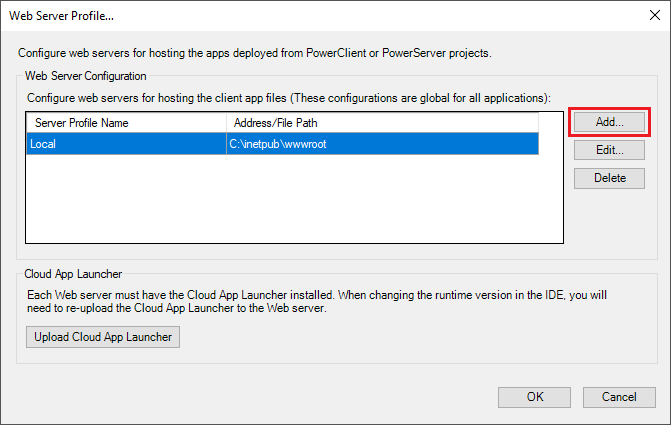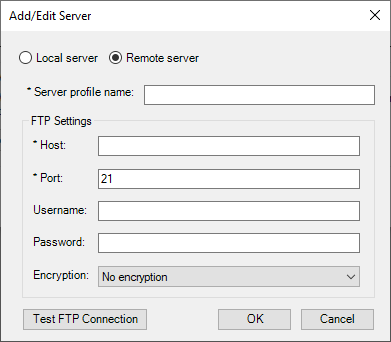A Web server is required to host the client-side of the installable cloud app deployed from the PowerServer project. If you have not set up any Web server yet, you can follow this tutorial Setting up a Web server.
Any type of Web server (such as IIS, Apache, Nginx etc.) is supported. You can set up FTP on the server, so that you can remotely deploy the app to the server. For how to configure FTP on a server running against IIS, refer to Creating an IIS FTP site. For how to configure SSL on a server running against IIS, refer to Configure an SSL-based FTP server.
To configure a deployment server:
-
Select Tools>Web Server Profile from the menu bar to open the Web Server Profile window.
-
In the Web Server Profile window, click the Add button.
-
In the Add/Edit Server window, select Local server or Remote server.
For a local server, specify the Web root full path (for example %systemdrive%\inetpub\wwwroot for IIS), and then click Test File Path to ensure the path is valid.
Note
If you intend to deploy to a local Web server, make sure you run PowerBuilder as administrator or have read and write permissions to the specified directory (read and write permissions are required when transferring files to the Web server).
For a remote server, specify a profile name and the connection settings for the FTP site (including host name, port number, FTP username, FTP password, and encryption), and then click Test FTP Connection to ensure the connection is successful.
-
Click OK. The server profile will be created.
The server configuration will be used by all PowerServer projects; therefore if you have changed the server settings, you will need to upload the app launcher if no launcher has been uploaded to that server or directory.
Note
If you intend to deploy to the Web server through a proxy server, make sure the proxy server and the FTP server have the same encoding, otherwise, the multi-byte characters in the file/folder name will become unrecognizable after being deployed to the server.
Note
As PowerBuilder is designed to be case-insensitive, therefore, in a case-sensitive system like Linux, some app files (such as images) may not be found or loaded. To avoid any issue caused by the case of file name, make sure to configure the Linux server to ignore case-sensitive.





